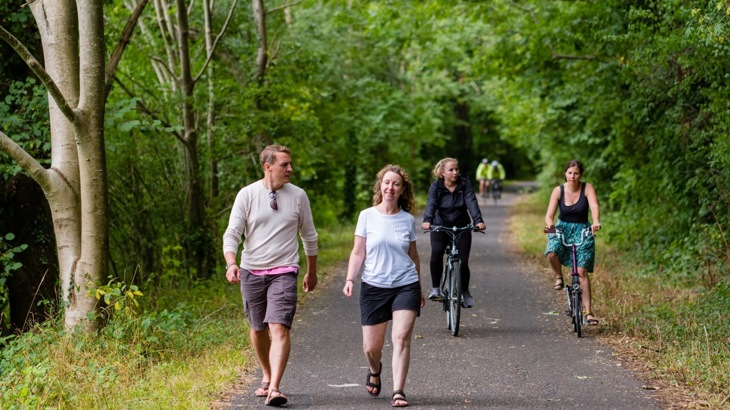Sustrans has been working with the All-Party Parliamentary Group on Longevity (APPGL) to consider what measures might help to extend healthy life expectancy by five years by 2035.

This blog is based on an extract from the Sustrans submission to the study.
There is currently an 18-year gap in healthy life expectancy between people in the most deprived communities and people in the least deprived communities in the UK.
Healthy life expectancy is the number of years that we can expect to live in a state of good health. This is different from life expectancy, which is the number of years that we can expect to live, irrespective of health conditions.
In the past, deaths from infectious diseases were common and often death would follow a relatively short period of illness.
We are now better at combatting some of these infectious diseases. Consequently, chronic, non-communicable diseases, including most cancers and heart diseases, have become the leading causes of death. This means that long periods of moderate and severe ill health in later life are more common.
The 18-year gap in healthy life expectancy shows the people in our most deprived communities are living with debilitating health conditions for almost two decades longer than is the case for people in our most affluent communities.
Reducing the gap in healthy life expectancy in deprived communities
The Healthy Life Expectancy plus 5 initiative (HLE+5) is about trying to expand that period of life that is not impacted by chronic ill health by five years, particularly for those in the most deprived communities.
The National Strategy for Healthier Longer Lives is looking for things that will contribute to extending healthy life expectancy. Sustrans has been working with the APPGL to advocate transport as a part of the solution.
We all need to travel, and we all need to be more active. Increasing active travel – walking and cycling – is an obvious solution, and it comes with many ‘co-benefits’.
From an active lifestyle to better air
The way we move can affect our lifestyle and also the environment around us, including air quality, carbon emissions, noise pollution, physical severance from places, and social exclusion.
Our dependence on motor vehicles has driven the climate change crisis and contributed to ill-health. This has led to social inequality, with people living in more deprived communities most likely to suffer from road danger and pollution, yet least likely to drive.
These transport challenges play out across major metropolitan areas and ‘left-behind’ towns and cities.
Active travel can make a big contribution to the HLE+5 agenda by increasing levels of physical activity, and by providing an alternative to more damaging forms of travel. Supporting active travel with significant capital investment now will offer huge returns over the decades to come.
Environments that support active travel by making it easier for people to get around by foot and cycle provide many benefits:
- Reducing traffic congestion – tackling the £7.9 billion annual economic cost (Inrix, 2018)
- Reducing pollution – cycling alone can save £9.3 billion over 10 years (Eunomia, 2017)
- NHS savings – cycling can avert 34,000 long-term health conditions in 7 UK cities (Sustrans, 2019)
- Boosting workplace productivity – active commuters are more productive
- Revitalising retail – people who travel actively to high streets spend more.
Our recommendations to make healthy life expectancy fair
An environment that signals receptivity to active travel makes it clear to the person walking and the person cycling that they take precedence.
Barriers are to vehicle movement rather than to person movement, controls hinder vehicles rather than hindering people, more space is assigned to the majority of people rather than to the minority travelling at low density, and facilities are geared towards active travellers (benches, cycle parking, play areas, etc).
Our specific recommendations to the National Strategy for Healthier Longer Lives include the following:
- Implement high levels of investment in safe infrastructure – consistent, high-quality design standards, changes to planning framework, behaviour change initiatives that support wider engagement and participation in active travel
- Design places and mobility systems that work for everyone – transform the economic appraisal system for transport; health outcomes and carbon emissions implications should be the primary determinants for transport investment
- Give the Department for Transport (DfT) accountability on health outcomes – this will mean closer collaboration, even a degree of integration, of (DfT) with the Department for Health and Social Care. DfT should also be held accountable for carbon emissions from transport
- Acknowledge the role of liveability and mobility in the economy, environment, planning, housing, education, recreation and other domains, and implement structures in local government to support these interfaces.
The gap in healthy life expectancy is unfair. Measures that can support a move to a more equitable share of healthy life expectancy should be prioritised by local and central governments. And active travel should be a priority for transport and health investment.






